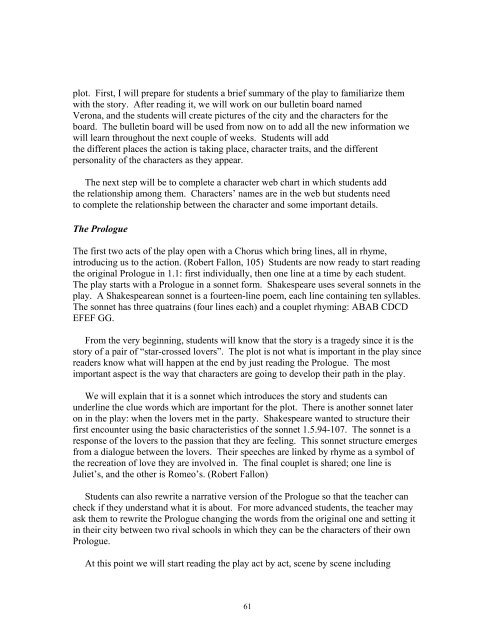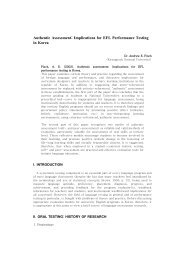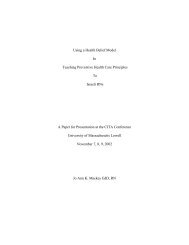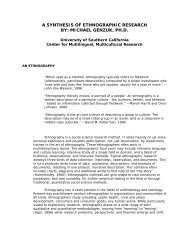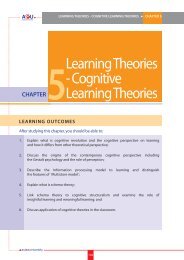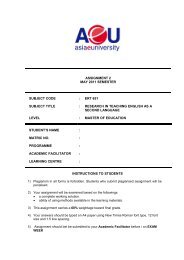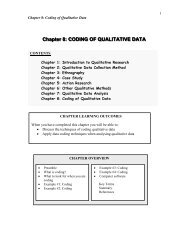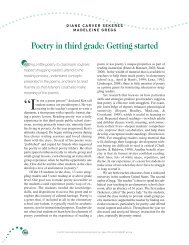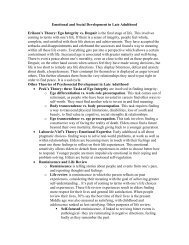Teaching Romeo and Juliet to ESL Students in ... - learningdomain
Teaching Romeo and Juliet to ESL Students in ... - learningdomain
Teaching Romeo and Juliet to ESL Students in ... - learningdomain
Create successful ePaper yourself
Turn your PDF publications into a flip-book with our unique Google optimized e-Paper software.
plot. First, I will prepare for students a brief summary of the play <strong>to</strong> familiarize themwith the s<strong>to</strong>ry. After read<strong>in</strong>g it, we will work on our bullet<strong>in</strong> board namedVerona, <strong>and</strong> the students will create pictures of the city <strong>and</strong> the characters for theboard. The bullet<strong>in</strong> board will be used from now on <strong>to</strong> add all the new <strong>in</strong>formation wewill learn throughout the next couple of weeks. <strong>Students</strong> will addthe different places the action is tak<strong>in</strong>g place, character traits, <strong>and</strong> the differentpersonality of the characters as they appear.The next step will be <strong>to</strong> complete a character web chart <strong>in</strong> which students addthe relationship among them. Characters’ names are <strong>in</strong> the web but students need<strong>to</strong> complete the relationship between the character <strong>and</strong> some important details.The PrologueThe first two acts of the play open with a Chorus which br<strong>in</strong>g l<strong>in</strong>es, all <strong>in</strong> rhyme,<strong>in</strong>troduc<strong>in</strong>g us <strong>to</strong> the action. (Robert Fallon, 105) <strong>Students</strong> are now ready <strong>to</strong> start read<strong>in</strong>gthe orig<strong>in</strong>al Prologue <strong>in</strong> 1.1: first <strong>in</strong>dividually, then one l<strong>in</strong>e at a time by each student.The play starts with a Prologue <strong>in</strong> a sonnet form. Shakespeare uses several sonnets <strong>in</strong> theplay. A Shakespearean sonnet is a fourteen-l<strong>in</strong>e poem, each l<strong>in</strong>e conta<strong>in</strong><strong>in</strong>g ten syllables.The sonnet has three quatra<strong>in</strong>s (four l<strong>in</strong>es each) <strong>and</strong> a couplet rhym<strong>in</strong>g: ABAB CDCDEFEF GG.From the very beg<strong>in</strong>n<strong>in</strong>g, students will know that the s<strong>to</strong>ry is a tragedy s<strong>in</strong>ce it is thes<strong>to</strong>ry of a pair of “star-crossed lovers”. The plot is not what is important <strong>in</strong> the play s<strong>in</strong>cereaders know what will happen at the end by just read<strong>in</strong>g the Prologue. The mostimportant aspect is the way that characters are go<strong>in</strong>g <strong>to</strong> develop their path <strong>in</strong> the play.We will expla<strong>in</strong> that it is a sonnet which <strong>in</strong>troduces the s<strong>to</strong>ry <strong>and</strong> students canunderl<strong>in</strong>e the clue words which are important for the plot. There is another sonnet lateron <strong>in</strong> the play: when the lovers met <strong>in</strong> the party. Shakespeare wanted <strong>to</strong> structure theirfirst encounter us<strong>in</strong>g the basic characteristics of the sonnet 1.5.94-107. The sonnet is aresponse of the lovers <strong>to</strong> the passion that they are feel<strong>in</strong>g. This sonnet structure emergesfrom a dialogue between the lovers. Their speeches are l<strong>in</strong>ked by rhyme as a symbol ofthe recreation of love they are <strong>in</strong>volved <strong>in</strong>. The f<strong>in</strong>al couplet is shared; one l<strong>in</strong>e is<strong>Juliet</strong>’s, <strong>and</strong> the other is <strong>Romeo</strong>’s. (Robert Fallon)<strong>Students</strong> can also rewrite a narrative version of the Prologue so that the teacher cancheck if they underst<strong>and</strong> what it is about. For more advanced students, the teacher mayask them <strong>to</strong> rewrite the Prologue chang<strong>in</strong>g the words from the orig<strong>in</strong>al one <strong>and</strong> sett<strong>in</strong>g it<strong>in</strong> their city between two rival schools <strong>in</strong> which they can be the characters of their ownPrologue.At this po<strong>in</strong>t we will start read<strong>in</strong>g the play act by act, scene by scene <strong>in</strong>clud<strong>in</strong>g61


